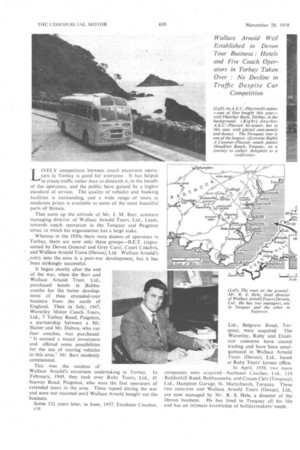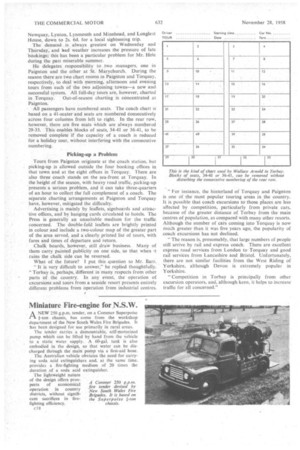Dmpetition Creates Traffic
Page 55

Page 54

Page 56

If you've noticed an error in this article please click here to report it so we can fix it.
By A. E. Sherlock-Mesher
LIVELY competition between coach excursion operators in Torbay is good for everyone. It has helped to create traffic rather than to diminish it, to the benefit of the operators, and the public have gained by a higher standard of service. The quality of vehicles and booking facilities is outstanding, and a wide range of tours at moderate prices is available to some of the most beautiful parts of Britain.
That sums up the attitude of Mr. J. M. Barr, assistant managing director of Wallace Arnold Tours, Ltd., Leeds, towards coach operation in the Torquay and Paignton areas, in which his organization has a large stake.
Whereas in the 1920s there were dozens of operators in Torbay, there are now only three groups—B.E.T. (repre. sented by Devon General and Grey Cars), Court Coaches, and Wallace Arnold Tours (Devon), Ltd. Wallace Arnold's entry into the area is a post-war development, but it has been strikingly successful.
It began shortly after the end of the war, when the Barr and Wallace Arnold Trust, Ltd., purchased hotels in Babbacombe for the better development of their extended-tour business from the north of England. Then in July, 1947, Waverley Motor Coach Tours, Ltd., 7 Torbay Road, Paignton, a partnership between a Mr. Slatter and Mr. Dalton, who ran four coaches, was purchased. "It seemed a sound investment and offered some possibilities for the use of touring vehicles in this area," Mr. Barr modestly commented.
This was the nucleus of Wallace Arnold's excursion undertaking in Torbay. In February, 1949, they took over Ruby Tours, Ltd., 45 Seaway Road, Paignton, who were the first operators of extended tours in the area. These lapsed during the war and were not resumed until Wallace Arnold bought out the business.
Some 124 years later, in June, 1957, Excelsior Coaches. el 6 Ltd., Belgrave Road, Torquay, were acquired. The Waverley, Ruby and Excelsior concerns have ceased trading and have been amalgamated in Wallace Arnold Tours (Devon), Ltd., based at Ruby Tours' former office.
In April, 1958, two more companies were acquired—Sunbeam Coaches, Ltd., 114 Reddenhill Road, Babbacombe, and Cream Cars (Torquay), Ltd., Hampton Garage, St. Marychurch, Torquay. These two conc;...rns and Wallace Arnold Tours (Devon), Ltd., are now managed by Mr. R. S. Hele, a director of the Devon business. He has lived in Torquay all his life and has an intimate knowledge of holidaymakers' needs, These three companies form a separate entity and their only connection with Wallace Arnold Tours, Ltd., is in their ownership by the Trust. The parent concern govern major items of expenditure, such as on new coaches, improvements to garages and on building work, and important matters of policy. As the director of the Trust responsible for the Torquay companies, Mr. J. M. Barr periodically discusses general policy with Mr. Hele, but in most other respects the Torbay interests are autonomous.
There is, however, some inter-hiring of vehicles owned by Wallace Arnold Tours and Feather Bros. (Tours), Ltd., another subsidiary of the Trust. The coaches in question are hired during their free days on extended tours from the north of England and from London.
The three Devon units are controlled basically as a group, although the fleet of 20 vehicles is divided equally between Torquay and Paignton-10 are based at Seaway. Road and 10 at St. Marychurch. Although the coaches average only 22,000 miles a year each, they are disposed of at the end of five years, so that the fleet always presents a high standard of appearance.
Three of the older models are Bedford Duple 41-seaters, 7 ft. 6 in. wide, which were purchased in 1956-57. All other bodywork is by Plaxtons (Scarborough), Ltd., and, apart from three 35-seaters, has 41 seats. Five Commer-Plaxton coaches (including the 35-seaters), some 8 ft. and the others 7 ft. 6 in. wide, date from 1955, and another five—all 7-ft. 9-in.-wide 41-seaters—from 1956. This year four A.E.C.Plaxtori 41-seaters (one 8 ft. and the others 7 ft. 9 in, wide) were purchased, and next year's intake will consist of another four of similar make and capacity, hut 7 ft. 6 in wide_ Vehicle width is important on narrow West Country roads, although naturally Wallace Arnold wish to give passengers the maximum comfort. Indeed, a bridge 7 ft. 10 in. wide is regularly crossed by a coach 7 ft. 9 in. wide. and without mishap. Automatic lubricators are being fitted to the latest coaches to reduce pressure on the maintenance staff during the season.
The fleet is fully licensed from Easter until September. Excursions and tours represent 90 per cent of the work and private hire the remainder. Mr. Hele makes every effort to increase contract work, and football parties provide a substantial volume of business in the. winter. There is also a large amount of private hire on Saturdays—the change-over day for holidaymakers—in the summer. Holiday tours are run during May and June, and September and October for the benefit of local residents who are fully engaged in catering for visitors in July and August.
Long day tours are, however, the basis of success, and 13 of them, occupying an average of 12 hours each, are scheduled. The most popular is to Looe and Polperro, and is run daily. The operating area extends from Newquay in the west to Bournemouth in the east and to Minehead in the north.
In addition, there are five day tours, averaging about eight hours each, of which the most patronized is to Princetown (to gaze at the forbidding walls of the gaol) and Plymouth. Buckfast Abbey heads the list of 11 popular afternoon trips. Six morning drives and three evening runs complete the schedule, apart from a special two-day week-end tour to Land's End and St. Ives at 79s. 6d. inclusive. Fares range from 19s. 6d. for tours to Newquay, Lynton, Lynmouth and Minehead, and Longleat House, down to 2s. 6d. for a local sightseeing trip.
The demand is always greatest on Wednesday and Thursday, and had weather increases the pressure of late 'bOokings; this has been a particular problem for Mr. Hele during the past miserable summer.
He delegates responsibility to. two managers, one in Paignton and the other at St. Marychurch. During the season there are two chart rooms in Paignton and Torquay, respectively, to deal with morning, afternoon and evening tours from each of the two adjoining towns—a new and successful system. All full-day tours are, however, charted in Torquay. Out-of-season charting is concentrated at Paignton.
All passengers have numbered seats. The coach chart is based on a 41-seater and seats are numbered Consecutively across four columns from left to right. In the rear row, however, there are five seats which are always numbered 29-33. This enables blocks of seats, 34-41 or 36-41, to be removed complete if the capacity of a coach is reduced for a holiday tour, without interfering with the consecutive numbering.
Picking-up a Problem Tours from Paignton originate at the coach station, but picking-up is allowed outside the four booking offices in that town and at the eight offices in Torquay. There .are also three coach stands on the sea-front at Torquay. In the height of the season, with heavy road traffic, picking-up presents a serious problem, and it can take three-quarters of an hour to collect the full complement of a coach.. The separate charting. arrangements at Paignton and Torquay
have, however, mitigated the difficulty. .
Advertising is mainly by leaflets, signboards and attractive offices, and by hanging cards circulated to hotels. The Press is generally an unsuitable medium for the traffic concerned. The double-fold leaflets are brightly 'printed in colour and include a two-colour map of the greater part of the area served, and a clearly printed list of tours, with fares and times of departure and return.
Chalk boards, however, still draw business. M.any of them carry painted publicity on one side, So that when it
• rains the chalk side can be reversed.
What of the future? I put this question to Mr. Barr.
".It is very difficult to answer," he replied thoughtfully. "Torbay is, perhaps, differentin many respects from other parts of the country. In any event, the operation of excursions'.and tours from a seaside resort presents entirely different problems from operation from industrial centres,
"For instance, the hinterland of Torquay and Paignton is one of the most popular touring areas in the country. It is possible that coach excursions to those places are less affected by competition, particularly from private cars, because of the greater distance of Torbay from the main 'centres of population, as compared with many other resorts. Although the number of cars coming into Torquay is now much greater than it was five years ago, the popularity of coach' excursions has not declined.
"The reason is, presumably, that large numbers of people still arrive by rail and express coach. There are excellent express. road services from London to Torquay and good rail • services from Lancashire and Bristol. Unfortunately, there are not similar facilities from the West Riding of Yorkshire, although Devon is extremely popular in
• Yorkshire.
"Competition in Torbay is principally from other excursion operators, and, although keen, it helps to increase traffic for all concerned." •












































































































